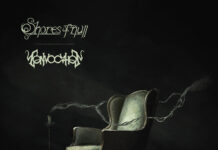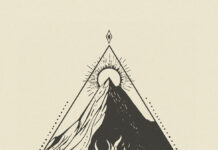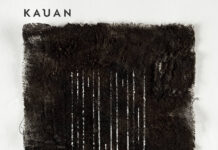After 6 years and a few line-up changes, Finland’s ISENGRIM from Kouvola are ready to release their fourth album, entitled “Maailmantappaja,” on November 11, 2021. ISENGRIM formed in 2004 and are influenced by ’90s Norwegian and Finnish black metal. They have distinguished themselves from these influences by adding unique vocals to the classic black metal sound. Compared to previous albums, “Maailmantappaja” explores the pagan metal genre by using themes from Norse mythology. ISENGRIM uses these Norse mythos while incorporating their roots by using the Finnish national instrument, the kantele, and singing in Finnish.

The “Maailmantappaja” album cover is drawn by Janne Virkki and depicts the scene in Norse mythology where Odin and Fenrir meet for the last time in the battle of Ragnarök. The red, black, and grey watercolor brings a stunning effect to the mood of the piece. The album cover hits my soft spot for Norse mythology and makes me want to listen to it, if I were to judge a book by its cover. The album’s concept involves the circle of life in Norse mythology, starting with ginnungagap or “the gaping void,” followed by the first giant, Ymir, who becomes the foundation for the nine realms. At the end of the circle comes the battle, Ragnarök, and the destruction following it, allowing the world to begin anew. The concept of the album mixed with a Finnish style is intriguing, so let’s jump in.
The album starts with the intro track, “Ajattomasta Tyhjyydestä.” The track is about one minute long and sounds slightly mystical. The song translates in English roughly to “from timeless emptiness”; the name is fitting, because it gives you a sense of the aforementioned ginnungagap before the worlds were created. The song flows into “Kuilun Lapset,” which starts quietly with a lovely arrangement of guitar and kantele. The vocals begin slowly, creating a chilling atmosphere as the rest of the instruments come in near the middle of the song, and the black metal style breaks through before slowing back down with some clean vocals at the end. ISENGRIM seem to be quite skilled at using different musical and vocal styles within songs, without losing any cohesion. “Vanha Saarni” is the newest single off the album and I can see why they chose it as such. I can picture “Vanha Saarni” being a live favorite, as the energy created by the smart guitar riffs and solos throughout, along with the strong drums, make it very head-bang-able.
From here on out, almost all songs are 6 minutes or longer. Next up is “Gungnir,” which is the name of Odin’s spear and is depicted on the album cover. “Gungnir” is likewise the first single released from the album. I also picture this being played live, with classic black metal vocals, then clean vocals with a catchy, singalong-able chorus. I understand why ISENGRIM chose this to be the first single, as it represents the album very well through the talents of each band member. Referencing the album cover while listening to it, one can easily imagine the battle between Odin and Fenrir while the music plays. After the complex epic that was “Gungnir,” the album moves to a simpler, but solid sounding song, “Kolmas;” which has a steady drumbeat and a guitar power chord progression at the beginning with some nice blast-beats and guitar solos. “Loimussa” has a nice acoustic start reminiscent of MOONSORROW‘s material. Slow, harsh vocals then come in before the heavy guitars and drums fill out the song, creating a rather relaxing atmosphere. The next song, “Ormr,” has some nice tremolo picking and technical guitar playing and the juxtaposition between the higher and lower register vocals is also a good touch. This song also has some great clean vocals near the 4-minute mark.
“Jäisten Virtojen Joutsen” is similar to the last song, coming into its own and winning listeners over at the halfway point, where there is a pleasant arrangement of guitar and kantele that mixes into the heavier music that precedes it. The song slows down at the end and we hear some wind blowing into the next track, “Naglfari.” In “Naglfari,” the guitarist, Wintry, cleanses our palate with kantele music, to remind us we are still listening to a Finnish band, just in case we forgot during the journey.
The last song on the album is the title track, “Maailmantappaja” (trans: world killer). The song starts off heavy with strong black metal vocals; the mix of black metal and clean vocals here are probably the best on the album. The song also accurately represents the band, as it shows the unique talents of both the instruments and vocals of its members. The end of the song slows down and there comes a calmness similar to that of the first track, which may represent the repetition of the world cycle.
This was an enjoyable album, definitely the best ISENGRIM have released yet, in my opinion. “Maailmantappaja” executed its theme well and sounds more polished than previous albums. A common problem for bands who incorporate clean vocals with growls is that the styles are not seamless, making them sound choppy. ISENGRIM succeeded at ensuring that this does not happen. Apart from the lead singer, Thaninivel, who obviously has a great vocal skill, the two other members who provide backing vocals, Wintry and Azelum, are also talented vocalists as well. This album was impressive and hopefully it catches the attention it deserves from both Finnish and an international audience.
Written by Sarah de Wolf
Tracklist
- Intro – Ajattomasta Tyhjyydestä
- Kuilun Lapset
- Vanha Saarni
- Gungnir
- Kolmas
- Loimussa
- Ormr
- Jäisten Virtojen Joutsen
- Naglfari
- Maailmantappaja
Lineup
Thaninivel– Vocals, Guitar
Wintry – Guitar, Kantele, Backing Vocals
Azelum – Bass, Backing Vocals
A.C – Drums
Label
Independent





